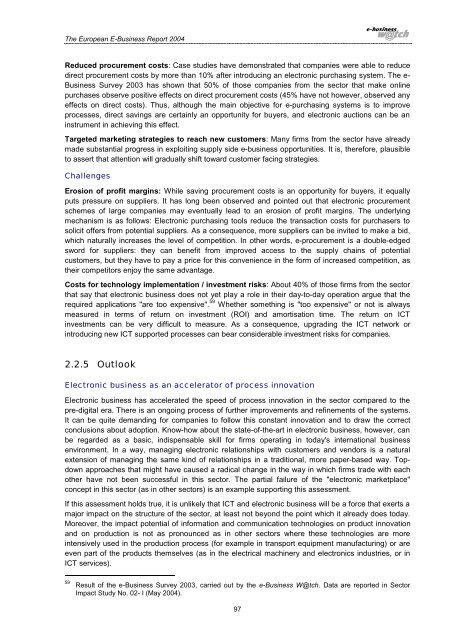The European e-Business Report 2004 - Berlecon Research GmbH
The European e-Business Report 2004 - Berlecon Research GmbH
The European e-Business Report 2004 - Berlecon Research GmbH
Create successful ePaper yourself
Turn your PDF publications into a flip-book with our unique Google optimized e-Paper software.
<strong>The</strong> <strong>European</strong> E-<strong>Business</strong> <strong>Report</strong> <strong>2004</strong>Reduced procurement costs: Case studies have demonstrated that companies were able to reducedirect procurement costs by more than 10% after introducing an electronic purchasing system. <strong>The</strong> e-<strong>Business</strong> Survey 2003 has shown that 50% of those companies from the sector that make onlinepurchases observe positive effects on direct procurement costs (45% have not however, observed anyeffects on direct costs). Thus, although the main objective for e-purchasing systems is to improveprocesses, direct savings are certainly an opportunity for buyers, and electronic auctions can be aninstrument in achieving this effect.Targeted marketing strategies to reach new customers: Many firms from the sector have alreadymade substantial progress in exploiting supply side e-business opportunities. It is, therefore, plausibleto assert that attention will gradually shift toward customer facing strategies.ChallengesErosion of profit margins: While saving procurement costs is an opportunity for buyers, it equallyputs pressure on suppliers. It has long been observed and pointed out that electronic procurementschemes of large companies may eventually lead to an erosion of profit margins. <strong>The</strong> underlyingmechanism is as follows: Electronic purchasing tools reduce the transaction costs for purchasers tosolicit offers from potential suppliers. As a consequence, more suppliers can be invited to make a bid,which naturally increases the level of competition. In other words, e-procurement is a double-edgedsword for suppliers: they can benefit from improved access to the supply chains of potentialcustomers, but they have to pay a price for this convenience in the form of increased competition, astheir competitors enjoy the same advantage.Costs for technology implementation / investment risks: About 40% of those firms from the sectorthat say that electronic business does not yet play a role in their day-to-day operation argue that therequired applications "are too expensive". 59 Whether something is "too expensive" or not is alwaysmeasured in terms of return on investment (ROI) and amortisation time. <strong>The</strong> return on ICTinvestments can be very difficult to measure. As a consequence, upgrading the ICT network orintroducing new ICT supported processes can bear considerable investment risks for companies.2.2.5 OutlookElectronic business as an accelerator of process innovationElectronic business has accelerated the speed of process innovation in the sector compared to thepre-digital era. <strong>The</strong>re is an ongoing process of further improvements and refinements of the systems.It can be quite demanding for companies to follow this constant innovation and to draw the correctconclusions about adoption. Know-how about the state-of-the-art in electronic business, however, canbe regarded as a basic, indispensable skill for firms operating in today's international businessenvironment. In a way, managing electronic relationships with customers and vendors is a naturalextension of managing the same kind of relationships in a traditional, more paper-based way. Topdownapproaches that might have caused a radical change in the way in which firms trade with eachother have not been successful in this sector. <strong>The</strong> partial failure of the "electronic marketplace"concept in this sector (as in other sectors) is an example supporting this assessment.If this assessment holds true, it is unlikely that ICT and electronic business will be a force that exerts amajor impact on the structure of the sector, at least not beyond the point which it already does today.Moreover, the impact potential of information and communication technologies on product innovationand on production is not as pronounced as in other sectors where these technologies are moreintensively used in the production process (for example in transport equipment manufacturing) or areeven part of the products themselves (as in the electrical machinery and electronics industries, or inICT services).59Result of the e-<strong>Business</strong> Survey 2003, carried out by the e-<strong>Business</strong> W@tch. Data are reported in SectorImpact Study No. 02- I (May <strong>2004</strong>).97
















